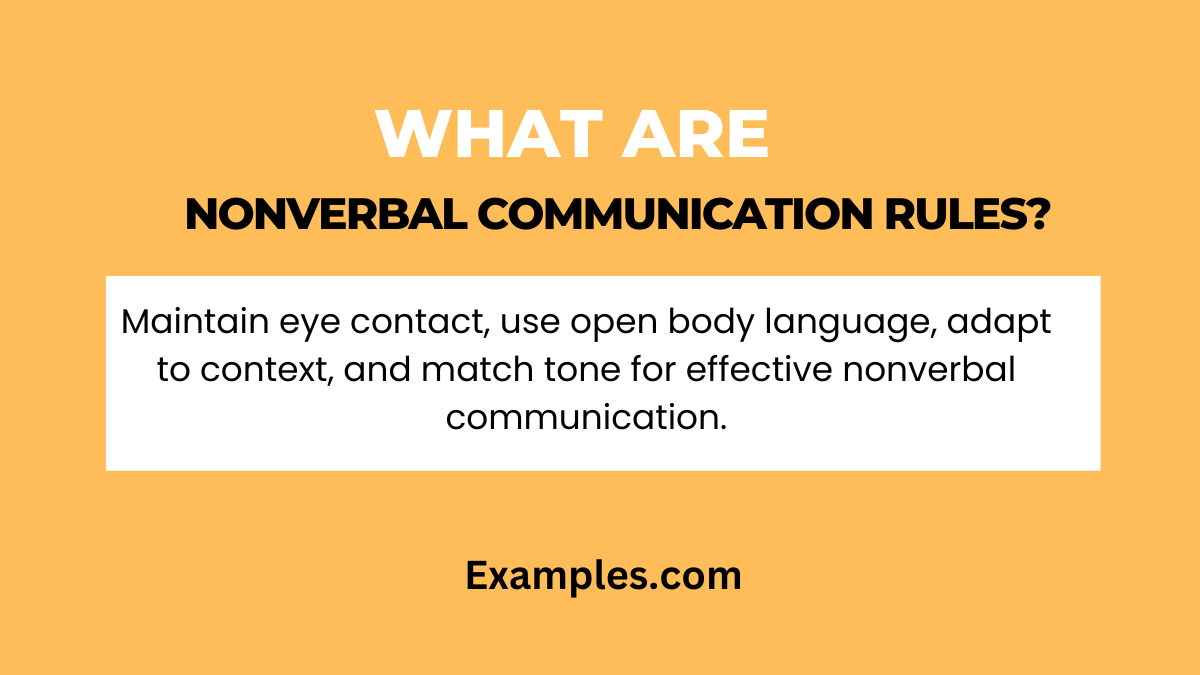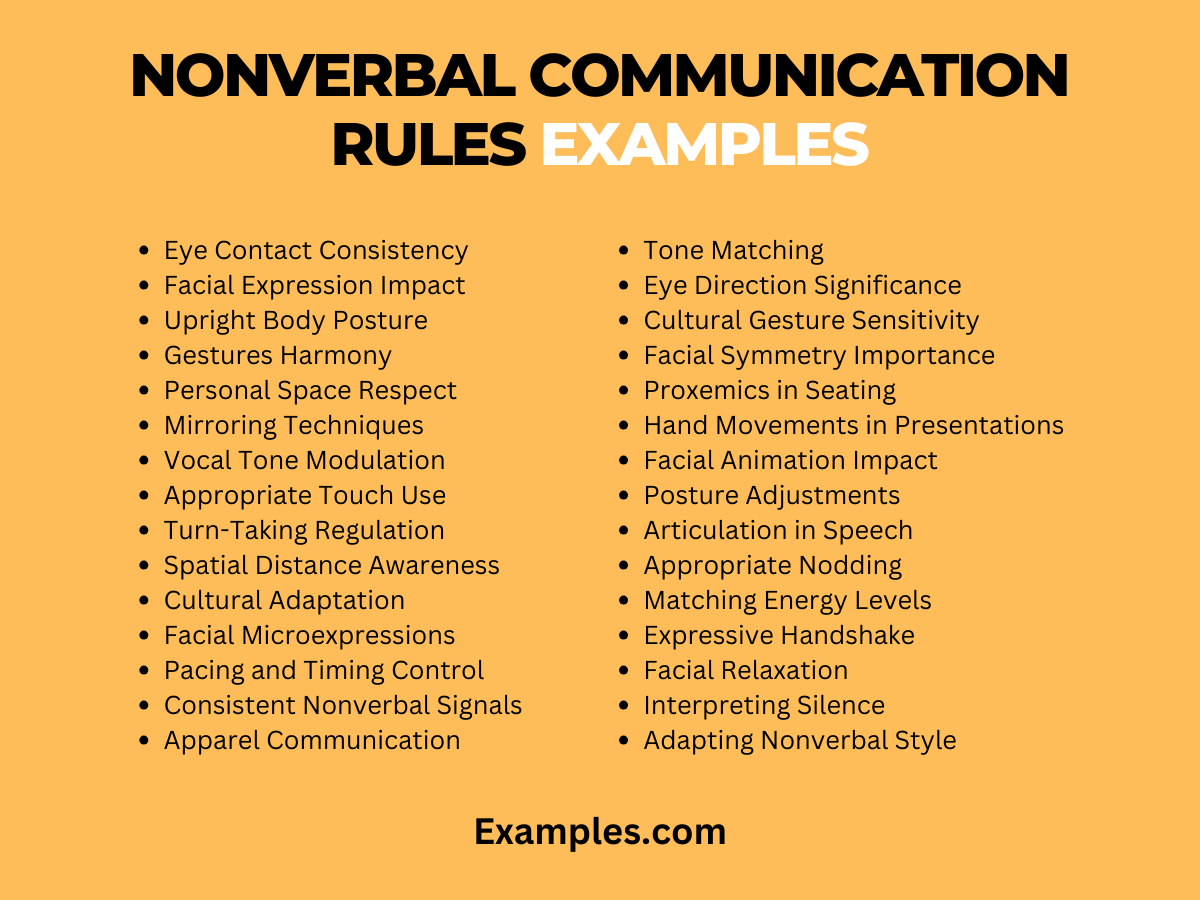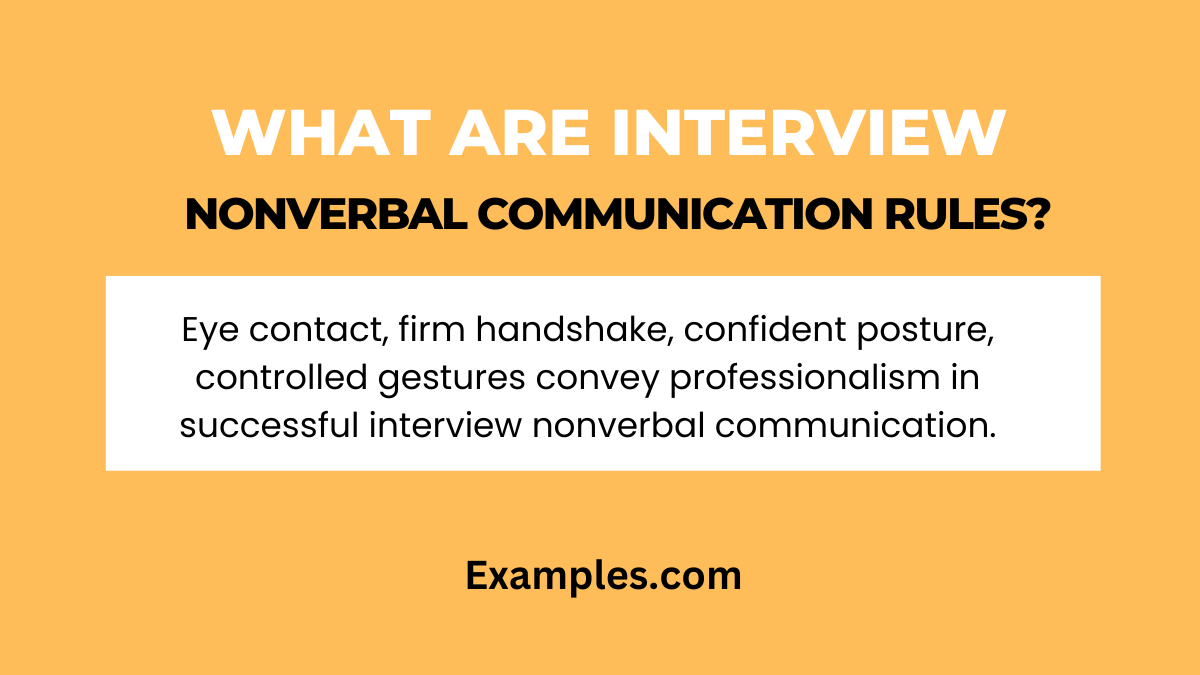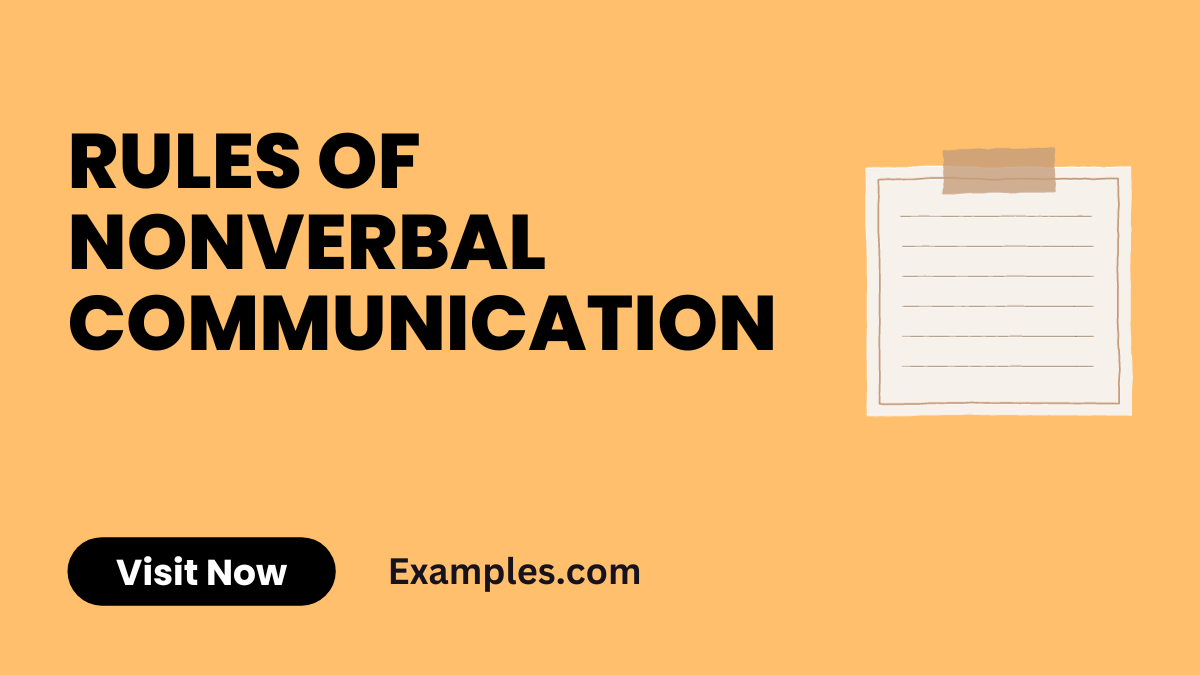29+ Rules Of Nonverbal Communication Examples
Navigating the subtle nuances of communication goes beyond spoken words. Discover the fundamental Rules of Nonverbal Communication, unraveling the silent language that shapes human interactions. From defining these rules to exploring practical examples, this comprehensive guide offers insights into how nonverbal cues influence relationships and foster effective communication.
What are the Rules of Nonverbal Communication?

In simple terms, Rules of Nonverbal Communication encompass the unspoken guidelines governing gestures, body language, and expressions. These silent cues convey emotions, intentions, and attitudes, shaping the dynamics of human connection. Understanding and mastering these rules are crucial for fostering meaningful interactions and interpreting the richness of nonverbal communication in various contexts.
30 Rules of Nonverbal Communication Examples

Delve into the intricate realm of nonverbal cues with these 30 essential Rules of Nonverbal Communication. Each rule shapes human interactions, influencing perceptions and connections. From body language to facial expressions, explore practical examples to master the art of silent communication and enhance your interpersonal skills effortlessly.
- Eye Contact: Establishing consistent eye contact during a conversation conveys attentiveness and fosters a deeper connection between communicators.
- Facial Expressions: A warm smile can instantly create a positive atmosphere, showcasing the power of facial expressions in nonverbal communication.
- Body Posture: Maintaining an upright and open posture signals confidence, contributing to a positive impression in social and professional settings.
- Gestures Harmony: Coordinating gestures with spoken words enhances clarity and reinforces the intended message, promoting effective communication.
- Personal Space Awareness: Respecting personal space in interactions demonstrates consideration and contributes to a comfortable and harmonious communication environment.
- Mirroring Techniques: Mirroring someone’s gestures subtly fosters rapport, creating a sense of connection and understanding in social interactions.
- Vocal Tone Variations: Modulating voice tone effectively conveys emotions, adding depth and nuance to verbal communication.
- Appropriate Touch: Using touch judiciously in communication, such as a friendly handshake, can strengthen connections and convey warmth.
- Regulating Turn-Taking: Nonverbal cues like nodding or brief pauses assist in smooth turn-taking during conversations, facilitating effective communication.
- Spatial Distance Awareness: Understanding the appropriate spatial distance in different contexts ensures comfortable and respectful communication.
- Adapting to Cultural Norms: Adhering to cultural nonverbal norms, like bowing or hand gestures, is crucial for effective cross-cultural communication.
- Facial Microexpressions: Brief facial expressions can reveal subtle emotions, providing insight into the speaker’s feelings beyond spoken words.
- Pacing and Timing: Controlling the pace of speech and timing in communication contributes to clarity and enhances overall effectiveness.
- Consistent Nonverbal Signals: Aligning verbal and nonverbal cues ensures coherence, minimizing the risk of misinterpretation in communication.
- Apparel Significance: Understanding the impact of clothing choices on communication helps convey professionalism and cultural awareness.
- Tone Matching: Adjusting one’s tone to match the context ensures communication resonates appropriately, promoting better understanding.
- Eye Direction Significance: The direction of eye gaze can indicate focus, interest, or even discomfort, enriching the nonverbal dimension of communication.
- Cultural Gesture Sensitivity: Being aware of culturally sensitive gestures prevents unintended misunderstandings and fosters cross-cultural harmony.
- Facial Symmetry Importance: Balanced facial expressions contribute to a genuine and trustworthy demeanor in various communication settings.
- Proxemics in Seating: Choosing appropriate seating distances contributes to comfort and engagement during group discussions or meetings.
- Hand Movements in Presentations: Purposeful hand movements during presentations enhance clarity and emphasize key points, aiding audience understanding.
- Facial Animation: Animated facial expressions during storytelling captivate listeners, making the narrative more engaging and memorable.
- Posture Adjustments: Adapting posture to the context, such as sitting attentively during a lecture, showcases active and respectful communication.
- Articulation in Speech: Clear articulation ensures that verbal communication is easily understood, minimizing chances of miscommunication.
- Appropriate Nodding: Nodding in agreement demonstrates active listening, fostering a positive and collaborative communication environment.
- Matching Energy Levels: Adjusting energy levels to match the situation contributes to effective communication, promoting a harmonious exchange of ideas.
- Expressive Handshake: A firm and expressive handshake conveys confidence and professionalism in various social and business interactions.
- Facial Relaxation: Maintaining a relaxed facial expression in casual conversations creates a comfortable and inviting atmosphere.
- Interpreting Silence: Understanding the nuanced meaning behind periods of silence contributes to effective communication in various scenarios.
- Adapting Nonverbal Style: Being flexible in nonverbal communication style based on the audience and context ensures adaptability and effectiveness.
Rules of Nonverbal Communication Examples for Students
Uncover the rules that shape student interactions beyond words. From respectful eye contact in class to collaborative gestures during group projects, these examples guide students in mastering nonverbal communication for effective and positive academic engagement.
- Interactive Classroom Posture: Sitting attentively and participating in class discussions signals engagement and respect for the learning environment.
- Expressive Study Groups: In study groups, using animated facial expressions and gestures enhances communication, fostering a collaborative and dynamic learning atmosphere.
- Engaging Eye Contact in Presentations: Maintaining eye contact during presentations not only captures the audience’s attention but also conveys confidence and credibility.
- Collaborative Team Project Gestures: Coordinating gestures within a team project emphasizes unity and shared goals, contributing to the project’s success.
- Nonverbal Respect in Group Discussions: Respecting personal space and turn-taking signals contribute to a positive and respectful atmosphere in student group discussions.
- Adaptable Study Environment: Adjusting spatial distance and nonverbal cues in different study settings ensures a comfortable and focused learning atmosphere.
- Interactive Study Breaks: During study breaks, matching energy levels and using expressive hand movements in conversations enhances camaraderie among students.
- Effective Classroom Seating: Choosing appropriate seating distances ensures a balanced spatial environment, contributing to a conducive learning atmosphere.
- Facial Engagement in Peer Feedback: Providing peer feedback with animated facial expressions enhances the understanding and impact of constructive criticism.
- Respectful Nonverbal Signals in Academic Events: Maintaining a respectful posture and facial expressions during academic events conveys professionalism and appreciation for the occasion.
Rules of Nonverbal Communication Examples in Real Life
Explore how nonverbal communication shapes everyday interactions in the real world. From navigating social events to expressing emotions, these examples showcase the versatility and impact of nonverbal cues in various real-life situations.
- Attentive Listening in Conversations: Using nonverbal cues like nodding and maintaining eye contact signals active listening during casual conversations.
- Cultural Sensitivity in International Travel: Adapting nonverbal gestures to align with local customs fosters respect and cultural understanding while traveling internationally.
- Expressive Body Language in Social Gatherings: Using open and expressive body language in social settings creates a welcoming atmosphere and encourages meaningful interactions.
- Professionalism in Job Interviews: Maintaining eye contact, a firm handshake, and appropriate posture convey confidence and professionalism during job interviews.
- Comfortable Nonverbal Dynamics in Family Gatherings: Understanding and respecting personal space among family members contributes to a comfortable and harmonious atmosphere in family gatherings.
- Supportive Nonverbal Cues in Emotional Moments: Offering a comforting touch and using empathetic facial expressions communicates support during challenging emotional situations.
- Effective Nonverbal Signals in Networking Events: Using confident body language and maintaining a warm smile enhances networking success in professional and social events.
- Adapting Communication Style in Business Meetings: Adjusting nonverbal communication to suit the formality of business meetings contributes to effective communication and collaboration.
- Navigating Nonverbal Signals in Group Outings: Observing and interpreting nonverbal cues in group outings helps individuals navigate social dynamics and foster positive connections.
- Balanced Nonverbal Expression in Public Speaking: Maintaining a balanced and controlled nonverbal expression during public speaking enhances the audience’s engagement and understanding.
Rules of Nonverbal Communication Examples at Workplace
Discover how nonverbal communication shapes the professional landscape. From effective meetings to fostering team dynamics, these workplace examples guide individuals in leveraging nonverbal cues for success in their professional endeavors.
- Confident Nonverbal Presence in Presentations: Using confident gestures, maintaining eye contact, and employing dynamic posture elevate the impact of presentations in the workplace.
- Team Building with Nonverbal Dynamics: Encouraging team members to use inclusive gestures and expressions fosters a sense of unity and collaboration within the workplace.
- Adaptable Nonverbal Signals in Diverse Work Environments: Being aware of and adapting nonverbal communication to diverse workplace cultures promotes inclusivity and effective teamwork.
- Leadership Presence in Boardroom Meetings: Leaders displaying assertive body language and engaging eye contact convey confidence and leadership in high-stakes boardroom meetings.
- Professionalism in Client Interactions: Maintaining a professional appearance, using appropriate gestures, and respecting personal space contribute to successful client interactions.
- Adapting Nonverbal Cues for Remote Collaboration: Navigating nonverbal communication in virtual meetings, such as using clear gestures and facial expressions, enhances remote collaboration.
- Dynamic Nonverbal Expression in Creative Brainstorming: Encouraging team members to use dynamic nonverbal cues during brainstorming sessions stimulates creativity and innovation.
- Crisis Management with Nonverbal Signals: Effectively using calming gestures and maintaining composure in crisis situations communicates stability and leadership.
- Collaborative Nonverbal Dynamics in Team Projects: Incorporating synchronized gestures and maintaining open body language fosters effective communication and teamwork in collaborative projects.
- Inclusive Nonverbal Cues in Meetings: Promoting inclusive body language, such as nodding and encouraging facial expressions, contributes to a positive and participatory meeting environment.
Mention the Types of Rules of Nonverbal Communication?

Understanding the diverse facets of nonverbal communication rules is essential for navigating social interactions effectively. Below is a detailed exploration of various types of rules, providing insight into the nuanced world of silent communication.
| Type | Description |
|---|---|
| Kinesics | Involves interpreting body movements, gestures, and facial expressions during communication. |
| Proxemics | Focuses on the use of personal space and spatial distance in communication dynamics. |
| Paralinguistics | Encompasses variations in tone, pitch, and vocal qualities that accompany verbal communication. |
| Haptics | Examines the role of touch in communication, emphasizing the impact of physical contact on interpersonal dynamics. |
| Oculesics | Involves the study of eye movements and eye contact, providing insights into emotional expression and engagement. |
| Chronemics | Explores the influence of time perception on communication, considering the impact of punctuality and timing. |
| Olfactics | Focuses on the use of scents and odors in communication, considering how smells impact perceptions and interactions. |
| Illustrators | Refers to the use of gestures that accompany verbal communication, enhancing the clarity and expressiveness of the message. |
| Regulators | Examines nonverbal cues used to control and coordinate the flow of communication, including nods, gestures, and other signals indicating turn-taking. |
| Emblems | Involves the use of specific gestures or symbols with well-defined meanings, often varying across cultures. |
What are Rules of Nonverbal Communication for Interviews?

Mastering nonverbal cues is vital for interview success. Follow these rules:
- Eye Contact: Maintain confident eye contact; avoid excess staring.
- Facial Expressions: Display genuine smiles, minimizing nervous expressions.
- Body Posture: Stand upright, open; avoid crossed arms.
- Handshake Etiquette: Offer a firm handshake, gauging grip based on norms.
- Spatial Awareness: Respect personal space; adjust based on cultural cues.
- Active Listening: Nod to show attentiveness; avoid fidgeting.
- Attire Alignment: Dress appropriately; align attire with company culture.
- Mirroring Techniques: Subtly mirror body language for rapport.
- Vocal Tone: Speak clearly, modulate tone effectively.
- Adapting to Interviewer’s Style: Align with the interviewer’s communication style.
Tips for Effective Nonverbal Communications
Elevate your nonverbal communication with these practical tips:
- Self-Awareness: Reflect on tendencies.
- Video Interview Prep: Test lighting, background.
- Practice in Front of a Mirror: Observe body language.
- Feedback Seeking: Request nonverbal feedback.
- Cultural Sensitivity: Understand variations.
- Consistency in Messaging: Align verbal and nonverbal.
- Mindful Gestures: Use purposeful gestures.
- Relaxation Techniques: Practice before interviews.
- Role Play Scenarios: Mock interviews with a friend.
- Continuous Improvement: Regularly assess and refine.
In professional and everyday scenarios, nonverbal communication significantly influences the outcomes of interactions. From job interviews to networking events, the ability to interpret and utilize nonverbal cues like eye contact, facial expressions, and body language can greatly enhance personal and professional relationships. These skills are not only useful in face-to-face interactions but also in the increasingly prevalent virtual settings, where adapting nonverbal communication is equally important??.
For those looking to delve deeper into the study of nonverbal communication, Harvard University offers extensive resources and courses on this subject. Their website (https://www.harvard.edu) provides access to a wealth of information and research in the field of communication.
Additionally, the Psychology Today website (https://www.psychologytoday.com) offers insightful articles and expert opinions on various aspects of nonverbal communication. This resource can be particularly helpful for individuals seeking to understand the psychological underpinnings of nonverbal cues and their impact on interpersonal relationships.



